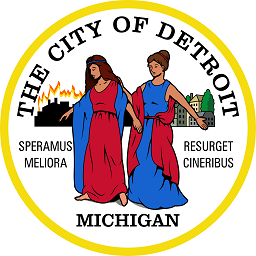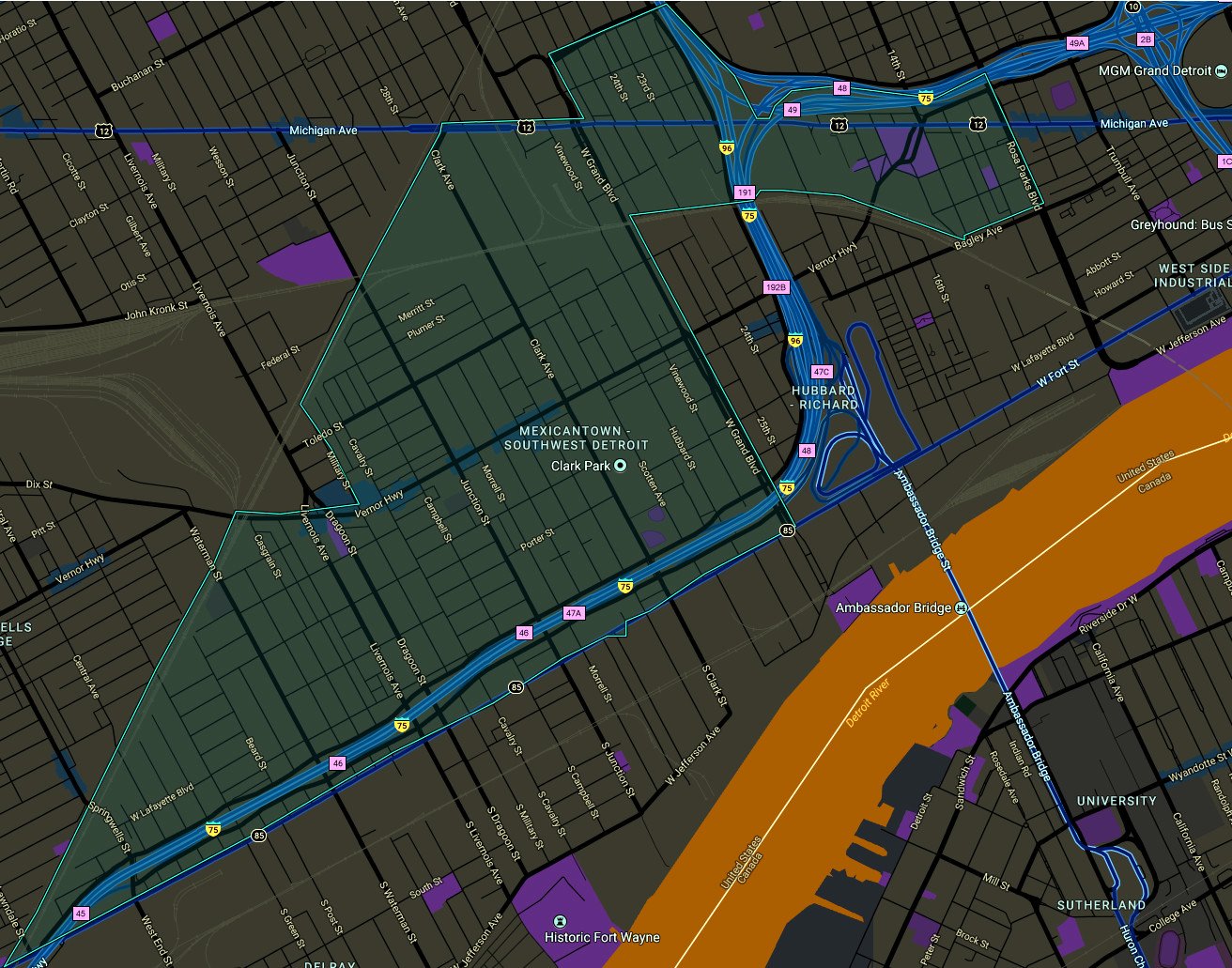Difference between revisions of "Detroit"
(→Economy) |
(→Introduction) |
||
| Line 253: | Line 253: | ||
Following World War II, the auto industry boomed and the metropolitan area became one of the largest in the United States. Immigrants and migrants have contributed significantly to Detroit's economy and culture. In the 1990s and the new millennium, the city has experienced increased revitalization. Many areas of the city are listed in the National Register of Historic Places and include National Historic Landmarks. The suburbs continue to grow, but the population of the city itself has plunged from a high of 1,849,568 in 1950 to 710,000 in 2010, with the non-Hispanic white element falling from 816,000 to 56,000. | Following World War II, the auto industry boomed and the metropolitan area became one of the largest in the United States. Immigrants and migrants have contributed significantly to Detroit's economy and culture. In the 1990s and the new millennium, the city has experienced increased revitalization. Many areas of the city are listed in the National Register of Historic Places and include National Historic Landmarks. The suburbs continue to grow, but the population of the city itself has plunged from a high of 1,849,568 in 1950 to 710,000 in 2010, with the non-Hispanic white element falling from 816,000 to 56,000. | ||
| + | |||
| + | === Beginnings === | ||
| + | The first recorded mention of the site was in 1670, when French missionaries found a stone idol venerated by the Indians there and destroyed it with an axe. Early settlers planted twelve missionary pear trees "named for the twelve Apostles" on the grounds of what is now Waterworks Park. | ||
| + | |||
| + | The city name comes from the Detroit River (French: le détroit du Lac Érie), meaning the strait of Lake Erie, linking Lake Huron and Lake Erie; in the historical context, the strait included Lake St. Clair and the St. Clair River. The sieur de Cadillac in 1698 proposed to his government in Paris that Detroit be established as a shelter for displaced Indian allies. Paris approved and in 1701 Cadillac led a party of 100 Frenchmen to establish a post called Fort Pontchartrain du Détroit, naming it after his sponsor the comte de Pontchartrain, Minister of Marine under Louis XIV. In 1704 he was given ownership over the strenuous opposition of officials in New France. An investigation by de Pontchartrain showed Cadillac was a tyrannical profiteer whose mischief hurt the French cause, so Cadillac was removed and sent to faraway New Orleans as governor of Louisiana. | ||
| + | |||
| + | :<span style="color:maroon;"> ''"When the Gascon adventurer Antoine Laumet, sieur de Cadillac, arrived at the strait between Lake Huron and Lake Erie on July 23, 1701, he and his one hundred men were not alone. Unknown to most, Antoine Laumet was the ghoul of Sylvestre d'Esparbes, a Toreador elder of great age who had formerly resided in the South of France. Ostensibly, the French party had come to the strait to establish a new fort on the orders of the French monarch Louis XIV, in the hopes of preventing British encroachment into the west and maintaining the French monopoly in the North American fur trade. In reality, Anoine Laumet and a mortal descendant of Sylvestre, born of noble blood called Lamothe Bardigues were to act as the elder Toreador's agents in French affairs and his daytime guardians."'' | ||
| + | |||
| + | :<span style="color:maroon;"> ''"Upon arrival, Antoine Laumet held a celebration to formally take control of the region, in honor of the Comte de Pontchartrain, his mortal patron and he named the new settlement as Fort Pontchartrain du Detroit. While the mortal soldiers were celebrating with wine and brandy, Sylvestre d'Esparbes drained a small native American tribe residing in the area, and in the process the Toreador elder revealed himself the other nocturnal hunters of the strait. Despite this event and following depredations by Sylvestre, the settlement experienced few if any difficulties."'' | ||
| + | |||
| + | Ste. Anne de Détroit, founded 1701, is the second oldest continuously operating Catholic parish in the United States; it was the first building erected in Detroit. | ||
| + | |||
| + | :<span style="color:maroon;"> ''"Sylvestre commanded that a storehouse and stockade be built for his protection, that project was handed over to Lamothe Bardigues, for the Toreador elder did not entirely trust the capabilities of the Gascon Laumet. Despite, Lamothe's best efforts, the first building completed was Ste. Anne's Church and so Sylvestre d'Esparbes took refuge from the day in a pit beneath the church where the corpses of the settlement's first casualties were laid to rest. Perhaps not as timely as his master might have wished, Lamothe did complete the stockade next, constructing it of logs with defensive bastions or towers in each corner. After the fort was established, some Ottawa and Huron moved into the area for the convenience of trading with the French. Although Sylvestre fed upon members of these tribes, the number of casualties remained low, due in part or in full to the efforts of Lamothe Bardigues to restrain his master and the artful way in which he explained away untimely deaths."'' | ||
| + | <br> | ||
| + | [[File:Fort Détroit.jpg]] | ||
| + | <br> | ||
| + | Once Fort Pontchartrain was completed, small groups of settlers made their way from Montreal to join those who had already established themselves thirty years before. The settlement surrounding the fort, came to be know informally as Detroit and over the next five years it not only grew larger, but more profitable as well. The first major conflict of Fort Detroit occurred in March 1706 while Cadillac was away. The Ottawa heard a rumor about a Huron tribe ambush. The Ottawa attacked and killed several members of the Miami tribe. The Miami sought safety in the fort, where they were defended by the soldiers. The French killed about 30 Ottawa warriors when they attacked the fort. After the battle, the Miami attacked an Ottawa village. In the conflict a French priest and sergeant were both caught outside the walls and killed. | ||
| + | |||
| + | Grants of free land attracted families to Detroit, which grew to 800 people in 1765. The main business was trading furs with the Indians, using goods supplied from Montreal. It was the largest French village between Montreal and New Orleans. Francois Marie Picoté, sieur de Belestre (Montreal 1719–1793), the last French commander at Fort Detroit (1758–1760), surrendered on November 29, 1760 to the British. They shortened the name to Detroit. | ||
| + | |||
| + | Demonstrating their independent power, several tribes in the region collaborated in Pontiac's Rebellion in 1763; they overran many smaller forts but could not subdue Detroit. | ||
Revision as of 23:01, 21 December 2018
Contents
- 1 Quote
- 2 Appearance
- 3 Introduction
- 4 City Device
- 5 Motto
- 6 Climate
- 7 Districts
- 8 Downtown Detroit
- 9 Demonym
- 10 Economy
- 11 History
Quote

“Detroit is largely composed, today, of seemingly endless square miles of low-density failure.” -― Jane Jacobs, The Death and Life of Great American Cities
Appearance
Introduction
Detroit is the most populous city in the U.S. state of Michigan and the largest city on the United States–Canada border. It is the seat of Wayne County, the most populous county in the state. It is a primary business, cultural, financial and transportation center in the Metro Detroit area, a region of 5.3 million people. It is a major port on the Detroit River, a strait that connects the Great Lakes system to the Saint Lawrence Seaway. It was founded on July 24, 1701, by the French explorer and adventurer Antoine Laumet de La Mothe, sieur de Cadillac and a party of settlers.
The Detroit area emerged as a significant metropolitan region within the United States in the early 20th century, and this trend only hastened in the 1950s and 1960s, with the construction of a regional freeway system. Detroit is the center of a three-county Urban Area (population 3,734,090, area of 1,337 square miles (3,460 km2), a 2010 United States Census) six-county Metropolitan Statistical Area (2010 Census population of 4,296,250, area of 3,913 square miles [10,130 km2]), and a nine-county Combined Statistical Area (2010 Census population of 5,218,852, area of 5,814 square miles [15,060 km2]). The Detroit–Windsor area, a commercial link straddling the Canada–U.S. border, has a total population of about 5,700,000. The Detroit metropolitan region holds roughly one-half of Michigan's population.
Known as the world's automotive center, "Detroit" is a metonym for the American automobile industry. Detroit's auto industry was an important element of the American "Arsenal of Democracy" supporting the Allied powers during World War II. It is an important source of popular music legacies celebrated by the city's two familiar nicknames, the Motor City and Motown. Other nicknames arose in the 20th century, including City of Champions, beginning in the 1930s for its successes in individual and team sport; The D; Hockeytown (a trademark owned by the city's NHL club, the Red Wings); Rock City (after the Kiss song "Detroit Rock City"); and The 313 (its telephone area code).
Between 2000 and 2010 the city's population fell by 25 percent, changing its ranking from the nation's 10th-largest city to 18th. In 2010, the city had a population of 713,777, more than a 60 percent drop from a peak population of over 1.8 million at the 1950 census. This resulted from suburbanization, industrial restructuring and the decline of Detroit's economic strength. Following the shift of population and jobs to its suburbs or other states or nations, the city focused on reestablishing itself as the metropolitan region's employment and economic center. Downtown Detroit has held an increased role as an entertainment destination in the 21st century, with the restoration of several historic theaters, several new sports stadiums, three new stadiums, and a riverfront revitalization project. More recently, the population of Downtown Detroit, Midtown Detroit, and a handful of other neighborhoods has increased. Many other neighborhoods remain distressed and even heavily abandoned.
The Governor of Michigan, Rick Snyder, declared a financial emergency for the city in March 2013, appointing an emergency manager. On July 18, 2013, Detroit filed the largest municipal bankruptcy case in U.S. history. It was declared bankrupt by Judge Steven W. Rhodes of the Bankruptcy Court for the Eastern District of Michigan on December 3, 2013; he cited its $18.5 billion debt and declared that negotiations with its thousands of creditors were unfeasible. On November 7, 2014, Judge Rhodes approved the city's bankruptcy plan, allowing the city to begin the process of exiting bankruptcy. The City of Detroit successfully left Chapter 9 municipal bankruptcy with all finances handed back to Detroit beginning at midnight on December 11, 2014.

"Once the hub of the United States' automotive manufacturing, Detroit, Michigan has become a shell of its former industrial self. Detroit is valuable territory for the Sabbat despite its economic woes, and the sect seeks to revitalize the city with a shift in industrial focus. With one of the highest murder rates in the United States, Detroit (which has been known as "the murder capital of the U.S.") provides ample feeding grounds for its dwellers. Unlike some of their brethren to the south, the Sabbat of Detroit do not concentrate on capturing neighboring Camarilla cities. Rather, the city's vampires focus on bolstering the flagging fortunes of their home. After all, the Sabbat must have the proper resources if it is to launch a successful attack..." -- Ja'ala Eli, Keeper of Chronicles
City Device
Motto
Speramus Meliora; Resurget Cineribus -- (Latin: We Hope For Better Things; It Shall Rise From the Ashes)
Climate
Detroit and the rest of southeastern Michigan have a humid continental climate which is influenced by the Great Lakes. Winters are cold, with moderate snowfall and temperatures not rising above freezing on an average 44 days annually, while dropping to or below 0 °F (−18 °C) on an average 4.4 days a year; summers are warm to hot with temperatures exceeding 90 °F (32 °C) on 12 days.[98] The warm season runs from May to September. The monthly daily mean temperature ranges from 25.6 °F (−3.6 °C) in January to 73.6 °F (23.1 °C) in July. Official temperature extremes range from 105 °F (41 °C) on July 24, 1934 down to −21 °F (−29 °C) on January 21, 1984; the record low maximum is −4 °F (−20 °C) on January 19, 1994, while, conversely the record high minimum is 80 °F (27 °C) on August 1, 2006, the most recent of five occurrences. A decade or two may pass between readings of 100 °F (38 °C) or higher, which last occurred July 17, 2012. The average window for freezing temperatures is October 20 thru April 22, allowing a growing season of 180 days.
Precipitation is moderate and somewhat evenly distributed throughout the year, although the warmer months such as May and June average more, averaging 33.5 inches (850 mm) annually, but historically ranging from 20.49 in (520 mm) in 1963 to 47.70 in (1,212 mm) in 2011. Snowfall, which typically falls in measurable amounts between November 15 through April 4 (occasionally in October and very rarely in May), averages 42.5 inches (108 cm) per season, although historically ranging from 11.5 in (29 cm) in 1881−82 to 94.9 in (241 cm) in 2013−14. A thick snowpack is not often seen, with an average of only 27.5 days with 3 in (7.6 cm) or more of snow cover. Thunderstorms are frequent in the Detroit area. These usually occur during spring and summer.
Districts
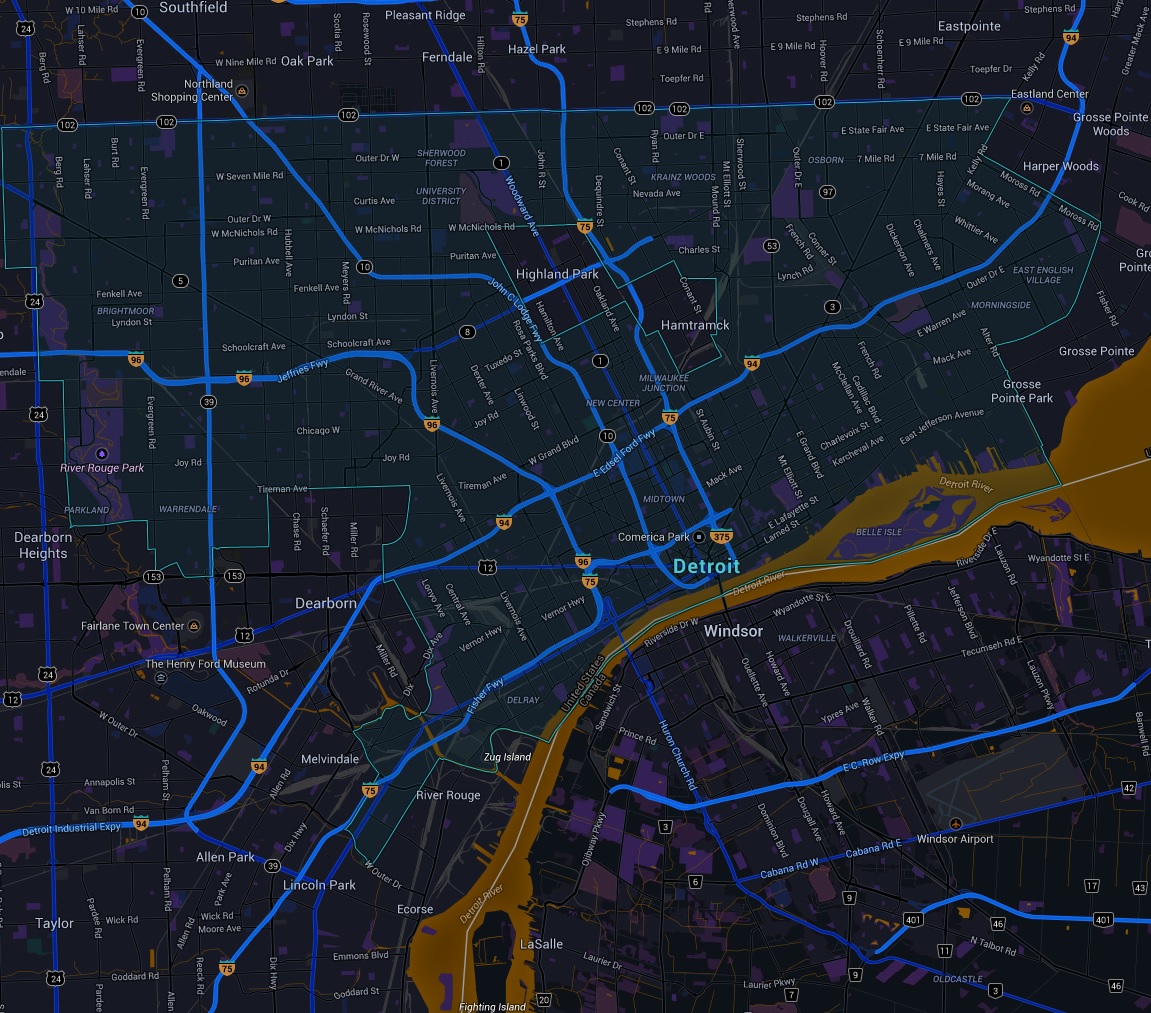
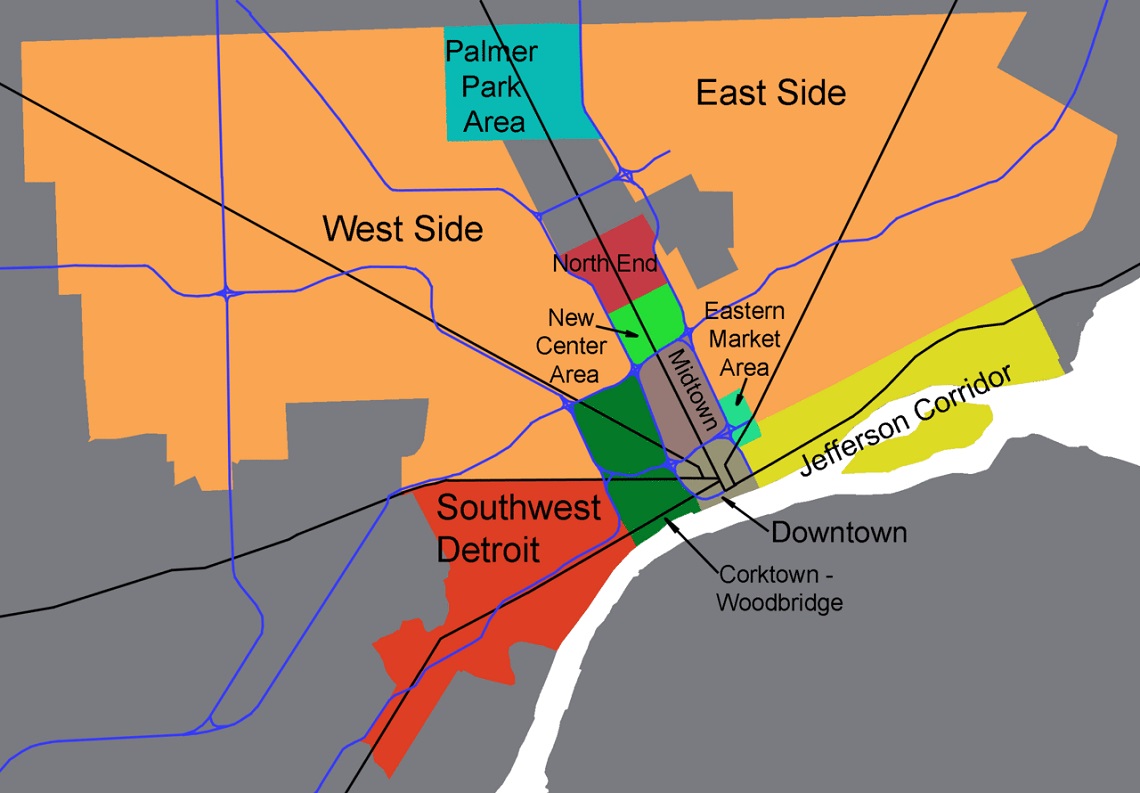
https://en.wikipedia.org/wiki/List_of_neighborhoods_in_Detroit
Downtown Detroit
Midtown

Midtown Detroit is an area covering roughly two square miles between Downtown Detroit to the south and New Center to the north along Woodward Avenue. Its boundaries are the Ford, Chrysler, Fisher, and Lodge Freeways. It includes the Art Center and the Medical Center in the northeast quadrant, Wayne State University's campus, the Detroit Public Library, and the Detroit Historical Museum in the northwest, and the Cultural Center including various restaurants, galleries, newly constructed lofts/condos and nightlife venues along Woodward in the center, among other things.
Art Center two Miles (3 km) north of downtown, is centered on the Cultural Center Historic District, which is listed in the National Register of Historic Places. The Cultural Center is roughly bounded by Cass Avenue to the west, I-75 to the east, I-94 to the north and Warren Avenue to the south. It also includes the East Ferry Avenue Historic District. Attractions include the Detroit Institute of Arts, the Charles H. Wright Museum of African American History, the Scarab Club, the Detroit Historical Museum, the Museum of Contemporary Art Detroit, the main library of the Detroit Public Library system and the Detroit Science Center. The College for Creative Studies is located adjacent the Scarab Club and opposite the East face of the Detroit Institute of Arts. The main campus of Wayne State University is located adjacent to the area, on the opposite side of Woodward.
Sub-districts
Places of Interest
- Detroit Masonic Temple -- Former Tremere Chantry of Detroit, now used exclusively by the Tremere Antitribu of the Sabbat. {Cass Park Historic District}
Sources
https://en.wikipedia.org/wiki/Midtown_Detroit
New Center Area
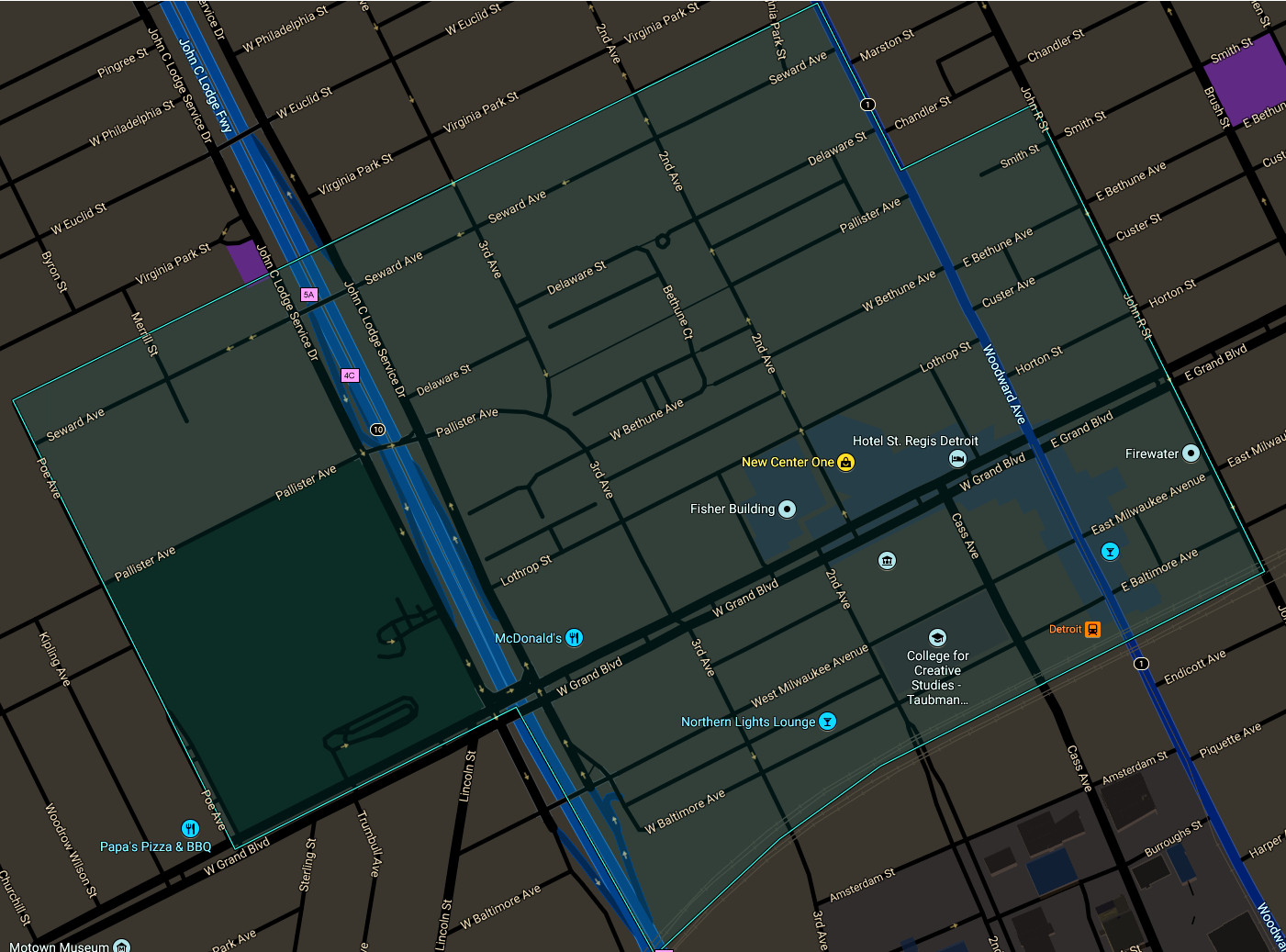
New Center is a commercial and residential historic district located uptown in Detroit, Michigan, adjacent to Midtown, one mile (1.6 km) north of the Cultural Center, and approximately three miles (5 km) north of Downtown. The area is centered just west of the intersection of Woodward Avenue and Grand Boulevard, and is approximately bounded by the Virginia Park Historic District on the north, the Edsel Ford Freeway (I-94) on the south, John R Street on the east and the Lodge Freeway on the west.
North End

The northern area includes the Detroit Golf Club and neighborhoods which surround the main campus of the University of Detroit Mercy: Pilgrim Village; Palmer Park Apartment Building Historic District; and the Palmer Woods Historic District. Pilgrim Village, developed in the 1920s, is bounded by Livernois, Idaho, Puritan and Fenkell. It is the birthplace of the Honey Baked Ham Company, which started on Fenkell in 1957. Palmer Park Apartment Building Historic District along with the nearby Palmer Woods Historic District are located within the area. Adjacent to the neighborhood is a 140-acre (0.6 km²) park named Palmer Park. The neighborhood and the park were the property of Thomas Witherell Palmer. The neighborhood consists of stately apartment buildings as well as some single-family detached homes.
Palmer Woods is known for its elm-lined streets, large brick homes, and Tudor style architecture. Palmer Woods is located on the west side of Detroit. It is bordered by 7 Mile Road, M-102 (8 Mile Road), M-1 (Woodward Avenue), and the Sherwood Forest neighborhood. Lots are large, with ample room for trees, play equipment, and a good expanse of grass. It is the home of physicians, academics, business owners, artists, executives and their families.
East Side
[[]]
Upper
Central

Central Detroit comprises three distinct areas that abut one another from south-east to north-west and include: Eastern Market, Forest Park and Poletown East.
Eastern Market

Eastern Market is a historic commercial district in Detroit, Michigan. It is located approximately one mile (1.6 km) northeast of the city's downtown and is bordered on the south by Gratiot Avenue, the north by Mack Avenue, the east by St. Aubin Street, and the west by Interstate 75 (I-75, Chrysler Freeway). The district was designated a Michigan State Historic Site in 1974 and listed on the National Register of Historic Places in 1978; the district's boundary was increased in 2007. The Eastern Market is located on the city's central east side near St. Joseph Roman Catholic Church and the Lafayette Park neighborhood. The market was transferred from city management in 2006, and now operates through a public-private partnership with the Eastern Market Corporation. Eastern Market is the largest historic public market district in the United States, and the Eastern Market farmer's distribution center is the largest open-air flowerbed market in the United States and has more than 150 foods and specialty businesses. On Saturdays, about 45,000 people shop the city's historic Eastern Market.
Forest Park
[[]]
Forest Park houses the St Albertus Roman Catholic Church and the Detroit Branch of the Federal Reserve Bank. It is a highly desirable neighborhood valued for the fact that demolition of blighted properties, beginning in 2008, started here first. As such, many tracts of land remain sparsely populated with a low density of residents.
Poletown East
[[]]
Poletown East is a neighborhood area of Detroit, Michigan bordering the enclave city of Hamtramck. The area was named after the Polish immigrants who originally lived in the area. A portion of residential area known as Poletown became the General Motors Detroit/Hamtramck Assembly plant in 1981 with those residents relocated by General Motors and the cities of Detroit and Hamtramck which claimed eminent domain in order to make way for a new automobile plant.
Lower
- Packard Automotive Plant -- A ruined automotive plant.
- The Packard Motel -- Last refuge of the fallen.
Corktown - Woodbridge
[[]]
Jefferson Corridor
[[]]
Eastern Market Area
[[]]
Southwest Detroit
Palmer Park Area
[[]]
East Side
[[]]
West Side
[[]]
Independent Cities of the Detroit Metro
Hamtramck -- Michigan's most ethnically diverse city.
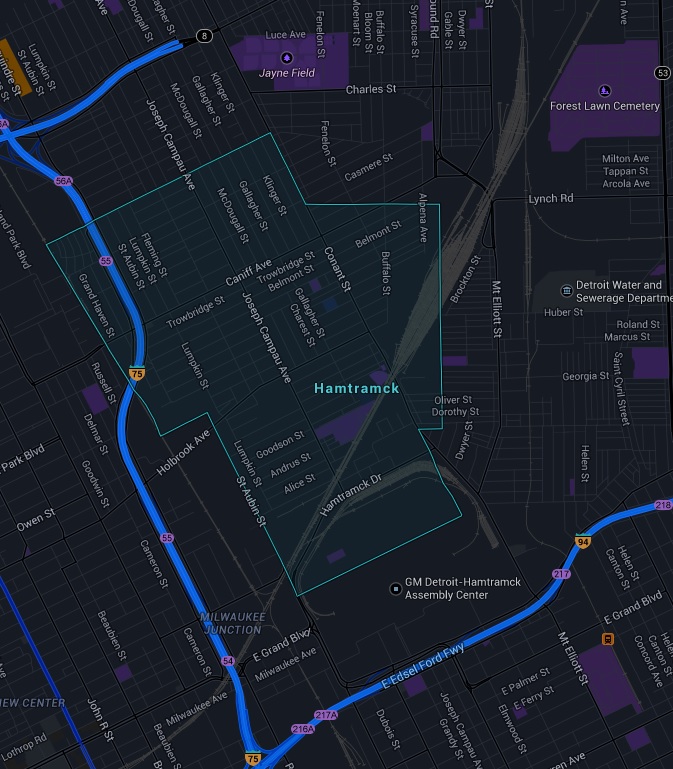
http://en.wikipedia.org/wiki/Hamtramck,_Michigan
Highland Park

http://en.wikipedia.org/wiki/Highland_Park,_Michigan
Demonym
Detroiter
Economy
Several major corporations are based in the city, including three Fortune 500 companies. The most heavily represented sectors are manufacturing (particularly automotive), finance, technology, and health care. The most significant companies based in Detroit include: General Motors, Quicken Loans, Ally Financial, Compuware, Shinola, American Axle, Little Caesars, DTE Energy, Lowe Campbell Ewald, Blue Cross Blue Shield of Michigan, and Rossetti Architects.
About 80,500 people work in downtown Detroit, comprising one-fifth of the city's employment base. Aside from the numerous Detroit-based companies listed above, downtown contains large offices for Comerica, Chrysler, HP Enterprise, Deloitte, PricewaterhouseCoopers, KPMG, and Ernst & Young. Ford Motor Company is located in the adjacent city of Dearborn.
Thousands more employees work in Midtown, north of the central business district. Midtown's anchors are the city's largest single employer Detroit Medical Center, Wayne State University, and the Henry Ford Health System in New Center. Midtown is also home to watchmaker Shinola and an array of small and startup companies. New Center bases TechTown, a research and business incubator hub that is part of the WSU system. Like downtown and Corktown, Midtown also has a fast-growing retailing and restaurant scene.
A number of the city's downtown employers are relatively new, as there has been a marked trend of companies moving from satellite suburbs around Metropolitan Detroit into the downtown core. Compuware completed its world headquarters in downtown in 2003. OnStar, Blue Cross Blue Shield, and HP Enterprise Services are located at the Renaissance Center. PricewaterhouseCoopers Plaza offices are adjacent to Ford Field, and Ernst & Young completed its office building at One Kennedy Square in 2006. Perhaps most prominently, in 2010, Quicken Loans, one of the largest mortgage lenders, relocated its world headquarters and 4,000 employees to downtown Detroit, consolidating its suburban offices. In July 2012, the U.S. Patent and Trademark Office opened its Elijah J. McCoy Satellite Office in the Rivertown/Warehouse District as its first location outside Washington, D.C.'s metropolitan area.
In April 2014, the Department of Labor reported the city's unemployment rate at 14.5%.
The city of Detroit and other private-public partnerships have attempted to catalyze the region's growth by facilitating the building and historical rehabilitation of residential high-rises in the downtown, creating a zone that offers many business tax incentives, creating recreational spaces such as the Detroit RiverWalk, Campus Martius Park, Dequindre Cut Greenway, and Green Alleys in Midtown. The city itself has cleared sections of land while retaining a number of historically significant vacant buildings in order to spur redevelopment; though it has struggled with finances, the city issued bonds in 2008 to provide funding for ongoing work to demolish blighted properties. Two years earlier, downtown reported $1.3 billion in restorations and new developments which increased the number of construction jobs in the city. In the decade prior to 2006, downtown gained more than $15 billion in new investment from private and public sectors.
Despite the city's recent financial issues, many developers remain unfazed by Detroit's problems. Midtown is one of the most successful areas within Detroit to have a residential occupancy rate of 96%. Numerous developments have been recently completely or are in various stages of construction. These include the $82 million reconstruction of downtown's David Whitney Building (now an Aloft Hotel and luxury residences), the Woodward Garden Block Development in Midtown, the residential conversion of the David Broderick Tower in downtown, the rehabilitation of the Book Cadillac Hotel (now a Westin and luxury condos) and Fort Shelby Hotel (now Doubletree) also in downtown, and various smaller projects.
Downtown's population of young professionals is growing and retail is expanding. A study in 2007 found out that Downtown's new residents are predominantly young professionals (57% are ages 25 to 34, 45% have bachelor's degrees, and 34% have a master's or professional degree), a trend which has hastened over the last decade. John Varvatos is set to open a downtown store in 2015, and Restoration Hardware is rumored to be opening a store nearby.
On July 25, 2013, Meijer, a midwestern retail chain, opened its first supercenter store in Detroit,; this was a 20 million dollar, 190,000-square-foot store in the northern portion of the city and it also is the centerpiece of a new 72 million dollar shopping center named Gateway Marketplace. On June 11, 2015, Meijer opened its second supercenter store in the city.
On May 21, 2014, JPMorgan Chase announced that it was injecting $100 million over five years into Detroit's economy, providing development funding for a variety of projects that would increase employment. It is the largest commitment made to any one city by the nation's biggest bank. Of the $100 million, $50 million will go toward development projects, $25 million will go toward city blight removal, $12.5 million will go for job training, $7 million will go for small businesses in the city, and $5.5 million will go toward the M-1 light rail project (Qline). On May 19, 2015, JPMorgan Chase announced that it has invested $32 million for two redevelopment projects in the city's Capitol Park district, the Capitol Park Lofts (the former Capitol Park Building) and the Detroit Savings Bank building at 1212 Griswold. Those investments are separate from Chase's five-year, $100-million commitment. On May 10, 2017, J.P. Morgan Chase & Co. announced a $50 million increase in the $100 million investment the firm committed to economic development and neighborhood stabilization in Detroit by 2019. Half of the $150 million will be grants and the other half is going to toward a variety of loan funds for small business growth, mixed-use real estate development and residential housing projects.
History
Introduction
The city of Detroit, the largest city in the state of Michigan, developed from a small fur trading post of New France to a world-class industrial powerhouse and the fourth largest American city by the mid 20th century. The city, settled in 1701, is the first European settlement above tidewater in North America. After a devastating fire in 1805, Augustus B. Woodward devised a street plan similar to Pierre Charles L'Enfant's design for Washington, D.C. Detroit's monumental avenues and traffic circles fan out in radial fashion from Campus Martius Park in the heart of the city, which facilitates traffic patterns along the city's tree-lined boulevards and parks. Main thoroughfares radiate outward from the city center like spokes in a wheel.
During the 19th century, Detroit grew into a thriving hub of commerce and industry, and the city spread along Jefferson Avenue, with multiple manufacturing firms taking advantage of the transportation resources afforded by the river and a parallel rail line. In the late 19th century several Gilded Age mansions were built just east of Detroit's current downtown. Detroit was referred to by some as the Paris of the West for its architecture, and for Washington Boulevard, recently electrified by Thomas Edison. Throughout the 20th century various skyscrapers were built centered on Detroit's downtown.
Following World War II, the auto industry boomed and the metropolitan area became one of the largest in the United States. Immigrants and migrants have contributed significantly to Detroit's economy and culture. In the 1990s and the new millennium, the city has experienced increased revitalization. Many areas of the city are listed in the National Register of Historic Places and include National Historic Landmarks. The suburbs continue to grow, but the population of the city itself has plunged from a high of 1,849,568 in 1950 to 710,000 in 2010, with the non-Hispanic white element falling from 816,000 to 56,000.
Beginnings
The first recorded mention of the site was in 1670, when French missionaries found a stone idol venerated by the Indians there and destroyed it with an axe. Early settlers planted twelve missionary pear trees "named for the twelve Apostles" on the grounds of what is now Waterworks Park.
The city name comes from the Detroit River (French: le détroit du Lac Érie), meaning the strait of Lake Erie, linking Lake Huron and Lake Erie; in the historical context, the strait included Lake St. Clair and the St. Clair River. The sieur de Cadillac in 1698 proposed to his government in Paris that Detroit be established as a shelter for displaced Indian allies. Paris approved and in 1701 Cadillac led a party of 100 Frenchmen to establish a post called Fort Pontchartrain du Détroit, naming it after his sponsor the comte de Pontchartrain, Minister of Marine under Louis XIV. In 1704 he was given ownership over the strenuous opposition of officials in New France. An investigation by de Pontchartrain showed Cadillac was a tyrannical profiteer whose mischief hurt the French cause, so Cadillac was removed and sent to faraway New Orleans as governor of Louisiana.
- "When the Gascon adventurer Antoine Laumet, sieur de Cadillac, arrived at the strait between Lake Huron and Lake Erie on July 23, 1701, he and his one hundred men were not alone. Unknown to most, Antoine Laumet was the ghoul of Sylvestre d'Esparbes, a Toreador elder of great age who had formerly resided in the South of France. Ostensibly, the French party had come to the strait to establish a new fort on the orders of the French monarch Louis XIV, in the hopes of preventing British encroachment into the west and maintaining the French monopoly in the North American fur trade. In reality, Anoine Laumet and a mortal descendant of Sylvestre, born of noble blood called Lamothe Bardigues were to act as the elder Toreador's agents in French affairs and his daytime guardians."
- "Upon arrival, Antoine Laumet held a celebration to formally take control of the region, in honor of the Comte de Pontchartrain, his mortal patron and he named the new settlement as Fort Pontchartrain du Detroit. While the mortal soldiers were celebrating with wine and brandy, Sylvestre d'Esparbes drained a small native American tribe residing in the area, and in the process the Toreador elder revealed himself the other nocturnal hunters of the strait. Despite this event and following depredations by Sylvestre, the settlement experienced few if any difficulties."
Ste. Anne de Détroit, founded 1701, is the second oldest continuously operating Catholic parish in the United States; it was the first building erected in Detroit.
- "Sylvestre commanded that a storehouse and stockade be built for his protection, that project was handed over to Lamothe Bardigues, for the Toreador elder did not entirely trust the capabilities of the Gascon Laumet. Despite, Lamothe's best efforts, the first building completed was Ste. Anne's Church and so Sylvestre d'Esparbes took refuge from the day in a pit beneath the church where the corpses of the settlement's first casualties were laid to rest. Perhaps not as timely as his master might have wished, Lamothe did complete the stockade next, constructing it of logs with defensive bastions or towers in each corner. After the fort was established, some Ottawa and Huron moved into the area for the convenience of trading with the French. Although Sylvestre fed upon members of these tribes, the number of casualties remained low, due in part or in full to the efforts of Lamothe Bardigues to restrain his master and the artful way in which he explained away untimely deaths."
File:Fort Détroit.jpg
Once Fort Pontchartrain was completed, small groups of settlers made their way from Montreal to join those who had already established themselves thirty years before. The settlement surrounding the fort, came to be know informally as Detroit and over the next five years it not only grew larger, but more profitable as well. The first major conflict of Fort Detroit occurred in March 1706 while Cadillac was away. The Ottawa heard a rumor about a Huron tribe ambush. The Ottawa attacked and killed several members of the Miami tribe. The Miami sought safety in the fort, where they were defended by the soldiers. The French killed about 30 Ottawa warriors when they attacked the fort. After the battle, the Miami attacked an Ottawa village. In the conflict a French priest and sergeant were both caught outside the walls and killed.
Grants of free land attracted families to Detroit, which grew to 800 people in 1765. The main business was trading furs with the Indians, using goods supplied from Montreal. It was the largest French village between Montreal and New Orleans. Francois Marie Picoté, sieur de Belestre (Montreal 1719–1793), the last French commander at Fort Detroit (1758–1760), surrendered on November 29, 1760 to the British. They shortened the name to Detroit.
Demonstrating their independent power, several tribes in the region collaborated in Pontiac's Rebellion in 1763; they overran many smaller forts but could not subdue Detroit.

